Responses and Post-Recovery of Physiological Traits after Drought–Heatwave Combined Event in 12 Urban Woody Species
Abstract
1. Introduction
- (1)
- How do hydraulic and photosynthesis traits dynamically change before, during and after drought–heatwave events in the 12 urban woody species?
- (2)
- How do the resistance and resilience of key physiological traits to drought–heatwave events differ between the following different urban woody functional groups: evergreen vs. deciduous, broadleaved vs. coniferous and trees vs. shrubs?
2. Materials and Methods
2.1. Study Site and Plant Species
2.2. Meteorological Data Collection and Tidying
2.3. Stem Hydraulic Conductivity and the Native Embolism Measurements
2.4. Water Potential Measurements
2.5. Photosynthesis Measurements
2.6. Leaf SPAD Value and Relative Water Content of Leaves
2.7. Data Analysis
3. Results
3.1. Dynamic Changes in Physiological Traits throughout Drought–Heatwave Event
3.2. Responses to and Recovery from Hot Drought among Different Functional Groups
4. Discussion
4.1. Dynamic Changes in Hydraulic and Photosynthesis Traits under Drought–Heatwave Event
4.2. Response to and Recovery from Drought–Heatwave Event among Different Plant Functional Groups
5. Conclusions
Author Contributions
Funding
Data Availability Statement
Acknowledgments
Conflicts of Interest
References
- Mei, M.; Gao, G.; Li, Y.; Wang, G.F.; Dai, T.L.; Chen, Y.X. Change characteristics in compound high temperature and drought extreme events over Yangtze, River Basin from 1961 to 2022. Yangtze River 2023, 54, 12–20. (In Chinese) [Google Scholar]
- IPCC. 2021: Summary for Policymakers. In Climate Change 2021: The Physical Science Basis. Contribution of Working Group I to the Sixth Assessment Report of the Intergovernmental Panel on Climate Change; Masson-Delmotte, V.P., Zhai, A., Pirani, S.L., Connors, C., Péan, S., Berger, N., Caud, Y., Chen, L., Goldfarb, M.I., Gomis, M., et al., Eds.; Cambridge University Press: Cambridge, UK; New York, NY, USA, 2021; pp. 3–32. [Google Scholar]
- Dietrich, L.; Delzon, S.; Hoch, G.; Kahmen, A. No role for xylem embolism or carbohydrate shortage in temperate trees during the severe 2015 drought. J. Ecol. 2019, 107, 334–349. [Google Scholar] [CrossRef]
- Sterl, A.; Severijns, C.; Dijkstra, H.; Hazeleger, W.; Jan van Oldenborgh, G.; van den Broeke, M.; van Velthoven, P. When can we expect extremely high surface temperatures? Geophys. Res. Lett. 2008, 35, 63–72. [Google Scholar] [CrossRef]
- De Marco, A.; Sicard, P.; Feng, Z.; Agathokleous, E.; Alonso, R.; Araminiene, V.; Augustatis, A.; Badea, O.; Beasley, J.C.; Branquinho, C.; et al. Strategic roadmap to assess forest vulnerability under air pollution and climate change. Glob. Chang. Biol. 2022, 28, 5062–5085. [Google Scholar] [CrossRef]
- Brahic, E.; Garms, M.; Deuffic, P.; Lyser, S.; Mayer, M. How do inhabitants of mountain areas perceive climate change and forest dieback? A comparison between France and Germany. Environ. Manag. 2022, 70, 896–910. [Google Scholar] [CrossRef]
- Rudel, T.K.; Meyfroidt, P.; Chazdon, R.; Bongers, F.; Sloan, S.; Grau, H.R.; Van Holt, T.; Schneider, L. Whither the forest transition? Climate change, policy responses, and redistributed forests in the twenty-first century. Ambio 2020, 49, 74–84. [Google Scholar] [CrossRef]
- Marusig, D.; Petruzzellis, F.; Tomasella, M.; Napolitano, R.; Altobelli, A.; Nardini, A. Correlation of Field-Measured and Remotely Sensed Plant Water Status as a Tool to Monitor the Risk of Drought-Induced Forest Decline. Forests 2020, 11, 77. [Google Scholar] [CrossRef]
- von Rein, I.; Gessler, A.; Premke, K.; Keitel, C.; Ulrich, A.; Kayler, Z.E. Forest understory plant and soil microbial response to an experimentally induced drought and heat-pulse event: The importance of maintaining the continuum. Glob. Chang. Biol. 2016, 22, 2861–2874. [Google Scholar] [CrossRef]
- Rennenberg, H.; Loreto, F.; Polle, A.; Brilli, F.; Fares, S.; Beniwal, R.S.; Gessler, A. Physiological responses of forest trees to heat and drought. Plant Biol. 2006, 8, 556–571. [Google Scholar] [CrossRef]
- Huang, S.; Knight, C.A.; Hoover, B.K.; Ritter, M. Leaf Functional Traits as Predictors of Drought Tolerance in Urban Trees. Urban For. Urban Green. 2020, 48, 126577. [Google Scholar] [CrossRef]
- Teskey, R.; Wertin, T.; Bauweraerts, I.; Ameye, M.; McGuire, M.A.; Steppe, K. Responses of tree species to heat waves and extreme heat events. Plant Cell Environ. 2015, 38, 1699–1712. [Google Scholar] [CrossRef]
- Marchin, R.M.; Backes, D.; Ossola, A.; Leishman, M.R.; Tjoelker, M.G.; Ellsworth, D.S. Extreme heat increases stomatal conductance and drought-induced mortality risk in vulnerable plant species. Glob. Chang. Biol. 2022, 28, 1133–1146. [Google Scholar] [CrossRef]
- Allen, C.D.; Macalady, A.K.; Chenchouni, H.; Bachelet, D.; McDowell, N.; Vennetier, M.; Kitzberger, T.; Rigling, A.; Breshears, D.D.; Hogg, E.H.; et al. Global overview of drought and heat-induced tree mortality reveals emerging climate change risks for forests. For. Ecol. Manag. 2010, 259, 660–684. [Google Scholar] [CrossRef]
- Allen, C.D.; Breshears, D.D.; McDowell, N.G. On underestimation of global vulnerability to tree mortality and forest die-off from hotter drought in the Anthropocene. Ecosphere 2015, 6, 1–55. [Google Scholar] [CrossRef]
- AzariJafari, H.; Xu, X.; Gregory, J.; Kirchain, R. Urban-Scale Evaluation of Cool Pavement Impacts on the Urban Heat Island Effect and Climate Change. Environ. Sci. Technol. 2021, 55, 11501–11510. [Google Scholar] [CrossRef]
- Manoli, G.; Fatichi, S.; Schläpfer, M.; Yu, K.; Crowther, T.W.; Meili, N.; Burlando, P.; Katul, G.G.; Bou-Zeid, E. Magnitude of urban heat islands largely explained by climate and population. Nature 2019, 573, 55–60. [Google Scholar] [CrossRef]
- Zhang, H.; Yin, Y.; An, H.; Lei, J.; Li, M.; Song, J.; Han, W. Surface urban heat island and its relationship with land cover change in five urban agglomerations in China based on GEE. Environ. Sci. Pollut. Res. 2022, 29, 82271–82285. (In Chinese) [Google Scholar] [CrossRef] [PubMed]
- Zhu, D.A.Y.; Zhou, Q.; Liu, M.M.; Bi, J. Non-optimum temperature-related mortality burden in China: Addressing the dual influences of climate change and urban heat islands. Sci. Total Environ. 2021, 782, 146760. [Google Scholar] [CrossRef]
- Zhou, D.C.; Zhao, S.Q.; Zhang, L.X.; Sun, G.; Liu, Y.Q. The footprint of urban heat island effect in China. Sci. Rep. 2015, 5, 11160. [Google Scholar] [CrossRef] [PubMed]
- Corumluoglu, O.; Asri, I. The effect of urban heat island on Izmir’s city ecosystem and climate. Environ. Sci. Pollut. Res. 2015, 22, 3202–3211. [Google Scholar] [CrossRef]
- IPCC. Climate Change 2021: The Physical Science Basis; Masson-Delmotte, V.P., Zhai, A., Pirani, S.L., Connors, C., Péan, S., Berger, N., Caud, Y., Chen, L., Goldfarb, M.I., Gomis, M., et al., Eds.; Cambridge University Press: Cambridge, UK, 2021. [Google Scholar]
- Han, Q.M.; Liu, Z.; Jia, J.W.; Anderson, B.T.; Xu, W.; Shi, P.J. Web-Based Data to Quantify Meteorological and Geographical Effects on Heat, Stroke: Case Study in China. Geohealth 2022, 6, e2022GH000587. [Google Scholar] [CrossRef]
- McCoy, D.E.; Goulet-Scott, B.; Meng, W.; Atahan, B.F.; Kiros, H.; Nishino, M.; Kartesz, J. Species clustering, climate effects, and introduced species in 5 million city trees across 63 US cities. Elife 2022, 11, e77891. [Google Scholar] [CrossRef] [PubMed]
- Ao, L.; Zhao, M.C.; Li, X.; Sun, G.Y. Different Urban Forest Tree Species Affect the Assembly of the Soil Bacterial and Fungal Community. Microb. Ecol. 2022, 83, 447–458. [Google Scholar] [CrossRef]
- Mhuireach, G.A.; Wilson, H.; Johnson, B.R. Urban Aerobiomes are Influenced by Season Vegetation, and Individual Site Characteristics. Ecohealth 2021, 18, 331–344. [Google Scholar] [CrossRef]
- Watkins, S.L.; Gerrish, E. The relationship between urban forests and race: A meta-analysis. J. Environ. Manag. 2018, 209, 152–168. [Google Scholar] [CrossRef]
- Keeler, B.L.; Hamel, P.; McPhearson, T.; Hamann, M.H.; Donahue, M.L.; Prado, K.A.M.; Arkema, K.K.; Bratman, G.N.; Brauman, K.A.; Finlay, J.C.; et al. Social-ecological and technological factors moderate the value of urban nature. Nat. Sustain. 2019, 2, 29–38. [Google Scholar] [CrossRef]
- McPherson, E.G.; Berry, A.M.; van Doorn, N.S. Performance testing to identify climate-ready trees. Urban For. Urban Green. 2018, 29, 28–39. [Google Scholar] [CrossRef]
- Esperon-Rodriguez, M.; Tjoelker, M.G.; Lenoir, J.; Baumgartner, J.B.; Beaumont, L.J.; Nipperess, D.A.; Power, S.A.; Richard, B.; Rymer, P.D.; Gallagher, R.V. Climate change increases global risk to urban forests. Nat. Clim. Chang. 2022, 12, 950–955. [Google Scholar] [CrossRef]
- Vitasse, Y.; Bottero, A.; Cailleret, M.; Bigler, C.; Fonti, P.; Gessler, A.; Lévesque, M.; Rohner, B.; Weber, P.; Rigling, A.; et al. Contrasting resistance and resilience to extreme drought and late spring frost in five major European tree species. Glob. Chang. Biol. 2019, 25, 3781–3792. [Google Scholar] [CrossRef]
- McDowell, N.G.; Sapes, G.; Pivovaroff, A.; Adams, H.D.; Allen, C.D.; Anderegg, W.R.L.; Arend, M.; Breshears, D.D.; Brodribb, T.; Choat, B.; et al. Mechanisms of woody-plant mortality under rising drought, CO2 and vapour pressure deficit. Nat. Rev. Earth Environ. 2022, 3, 294–308. [Google Scholar] [CrossRef]
- Tan, P.Y.; Wong, N.H.; Tan, C.L.; Jusuf, S.K.; Schmiele, K.; Chiam, Z.Q. Transpiration and cooling potential of tropical urban trees from different native habitats. Sci. Total Environ. 2020, 705, 135764. [Google Scholar] [CrossRef]
- Ghimire, C.P.; Bruijnzeel, L.A.; Lubczynski, M.W.; Zwartendijk, B.W.; Odongo, V.O.; Ravelona, M.; Van Meerveld, H.J. Transpiration and stomatal conductance in a young secondary tropical montane forest: Contrasts between native trees and invasive understorey shrubs. Tree Physiol. 2018, 38, 1053–1070. [Google Scholar] [CrossRef]
- Will, R.E.; Wilson, S.M.; Zou, C.B.; Hennessey, T.C. Increased vapor pressure deficit due to higher temperature leads to greater transpiration and faster mortality during drought for tree seedlings common to the forest-grassland ecotone. New Phytol. 2013, 200, 366–374. [Google Scholar] [CrossRef]
- Lambers, H.; Poorter, H. Inherent Variation in Growth Rate Between Higher Plants: A Search for Physiological Causes and Ecological Consequences. Adv. Ecol. Res. 1992, 23, 187–261. [Google Scholar]
- Sperry, J.S.; Tyree, M.T. Mechanism of water stress-induced xylem embolism. Plant Physiol. 1988, 88, 581–587. [Google Scholar] [CrossRef]
- Schuldt, B.; Buras, A.; Arend, M.; Vitasse, Y.; Beierkuhnlein, C.; Damm, A.; Gharun, M.; Grams, T.E.E.; Hauck, M.; Hajek, P.; et al. A first assessment of the impact of the extreme 2018 summer drought on Central European forests. Basic Appl. Ecol. 2020, 45, 86–103. [Google Scholar] [CrossRef]
- Arend, M.; Link, R.M.; Patthey, R.; Hoch, G.; Schuldt, B.; Kahmen, A. Rapid hydraulic collapse as cause of drought-induced mortality in conifers. Proc. Natl. Acad. Sci. USA 2021, 118, e2025251118. [Google Scholar] [CrossRef] [PubMed]
- Choat, B.; Brodribb, T.J.; Brodersen, C.R.; Duursma, R.A.; Lopez, R.; Medlyn, B.E. Triggers of tree mortality under drought. Nature 2018, 558, 531–539. [Google Scholar] [CrossRef]
- Bennett, A.C.; McDowell, N.G.; Allen, C.D.; Anderson-Teixeira, K.J. Larger trees suffer most during drought in forests worldwide. Nat. Plants 2015, 1, 15139. [Google Scholar] [CrossRef] [PubMed]
- Gillner, S.; Korn, S.; Hofmann, M.; Roloff, A. Contrasting strategies for tree species to cope with heat and dry conditions at urban sites. Urban Ecosyst. 2017, 20, 853–865. [Google Scholar] [CrossRef]
- Esperon-Rodriguez, M.; Power, S.A.; Tjoelker, M.G.; Marchin, R.M.; Rymer, P.D. Contrasting heat tolerance of urban trees to extreme temperatures during heatwaves. Urban For. Urban Green. 2021, 66, 127387. [Google Scholar] [CrossRef]
- Marchin, R.M.; Esperon-Rodriguez, M.; Tjoelker, M.G.; Ellsworth, D.S. Crown dieback and mortality of urban trees linked to heatwaves during extreme drought. Sci. Total Environ. 2022, 850, 157915. [Google Scholar] [CrossRef] [PubMed]
- Petruzzellis, F.; Tordoni, E.; Di Bonaventura, A.; Tomasella, M.; Natale, S.; Panepinto, F.; Bacaro, G.; Nardini, A. Turgor loss point and vulnerability to xylem embolism predict species-specific risk of drought-induced decline of urban trees. Plant Biol. 2022, 24, 1198–1207. [Google Scholar] [CrossRef] [PubMed]
- Sanusi, R.; Livesley, S.J. London Plane trees (Platanus x acerifolia) before, during and after a heatwave: Losing leaves means less cooling benefit. Urban For. Urban Green. 2020, 54, 126746. [Google Scholar] [CrossRef]
- Sjöman, H.; Hirons, A.D.; Bassuk, N.L. Urban forest resilience through tree selection—Variation in drought tolerance in Acer. Urban For. Urban Green. 2015, 14, 858–865. [Google Scholar] [CrossRef]
- Khan, M.K.; Naeem, K.; Huo, C.H.; Hussain, Z. The Nexus between Vegetation Urban Air Quality, and Public Health: An Empirical Study of Lahore. Front. Public Health 2022, 10, 842125. [Google Scholar] [CrossRef] [PubMed]
- Schollaert, C.; Ackley, R.C.; DeSantis, A.; Polka, E.; Scammell, M.K. Natural gas leaks and tree death: A first-look case-control study of urban trees in Chelsea MA USA. Environ. Pollut. 2020, 263, 114464. [Google Scholar] [CrossRef]
- De Kauwe, M.G.; Medlyn, B.E.; Ukkola, A.M.; Mu, M.; Sabot, M.E.B.; Pitman, A.J.; Meir, P.; Cernusak, L.A.; Rifai, S.W.; Choat, B.; et al. Identifying areas at risk of drought-induced tree mortality across South-Eastern Australia. Glob. Chang. Biol. 2020, 26, 5716–5733. [Google Scholar] [CrossRef]
- Deng, C.L.; She, D.X.; Zhang, L.P.; Zhang, Q.; Liu, X.; Wang, S.X. Characteristics of drought events using three-dimensional graph connectedness recognition method in the Yangtze River Basin, China. Trans. Chin. Soc. Agric. Eng. 2021, 37, 131–139. (In Chinese) [Google Scholar]
- Zhang, Y.; Ayyub, B.M.; Zhang, D.; Huang, H.; Saadat, Y. Impact of Water Level Rise on Urban Infrastructures: Washington, DC, and Shanghai as Case Studies. Risk Anal. 2019, 39, 2718–2731. [Google Scholar] [CrossRef]
- Yu, H. In 2022, global high temperature weather caused disasters, and the air conditioning compressor industry cannot only consider scale. Electr. Equip. 2022, 8, 7–9. (In Chinese) [Google Scholar]
- Li, M.H.; Xiao, S.Z. Diameter-Height Models of Main Tree Species in Shanghai. Acta Agric. Univ. Jiangxiensis 2019, 41, 501–511. (In Chinese) [Google Scholar]
- Zhang, H.M.; Wu, B.F.; Yan, N.N. Remote sensing estimates of vapor pressure deficit: An overview. Adv. Earth Sci. 2014, 29, 559–568. (In Chinese) [Google Scholar]
- Vicente-Serrano, S.M.; Santiago, B.; Juan, I.; López-Moreno, A. Multi-scalar drought index sensitive to global warming: The Standardized Precipitation Evapotranspiration Index—SPEI. J. Clim. 2010, 23, 1696–1718. [Google Scholar] [CrossRef]
- Vicente-Serrano, S.M.; Begueria, S.; Lopez-Moreno, J.I.; Angulo, M.; El Kenawy, A. A New Global 0.5 degrees Gridded Dataset (1901–2006) of a Multiscalar Drought Index: Comparison with Current Drought Index Datasets Based on the Palmer Drought Severity Index. J. Hydrometeorol. 2010, 11, 1033–1043. [Google Scholar] [CrossRef]
- Vicente-Serrano, S.M.; Beguería, S.; Lorenzo-Lacruz, J.; Camarero, J.J.; López-Moreno, J.I.; Azorin-Molina, C.; Revuelto, J.; Morán-Tejeda, E.; Sanchez-Lorenzo, A. Performance of Drought Indices for Ecological, Agricultural, and Hydrological Applications. Earth Interact. 2012, 16, 1–27. [Google Scholar] [CrossRef]
- Wheeler, J.K.; Huggett, B.A.; Tofte, A.N.; Rockwell, F.E.; Holbrook, N.M. Cutting xylem under tension or supersaturated with gas can generate PLC and the appearance of rapid recovery from embolism. Plant Cell Environ. 2013, 36, 1938–1949. [Google Scholar] [CrossRef]
- Song, J.; Yang, D.; Niu, C.Y.; Zhang, W.W.; Wang, M.; Hao, G.Y. Correlation between leaf size and hydraulic architecture in five compound-leaved tree species of a temperate forest in NE China. For. Ecol. Manag. 2018, 418, 63–72. [Google Scholar] [CrossRef]
- Liu, Y.Y.; Song, J.; Wang, M.; Li, N.; Niu, C.Y.; Hao, G.Y. Coordination of xylem hydraulics and stomatal regulation in keeping the integrity of xylem water transport in shoots of two compound-leaved tree species. Tree Physiol. 2015, 35, 1333–1342. [Google Scholar] [CrossRef]
- Niu, C.Y.; Meinzer, F.C.; Hao, G.Y. Divergence in strategies for coping with winter embolism among co-occurring temperate tree species: The role of positive xylem pressure, wood type and tree stature. Funct. Ecol. 2017, 31, 1550–1560. [Google Scholar] [CrossRef]
- Wang, A.-Y.; Wang, M.; Yang, D.; Song, J.; Zhang, W.-W.; Han, S.-J.; Hao, G.-Y. Responses of hydraulics at the whole-plant level to simulated nitrogen deposition of different levels in Fraxinus mandshurica. Tree Physiol. 2016, 36, 1045–1055. [Google Scholar] [CrossRef] [PubMed]
- Hunt, E.R.; Daughtry, C.S.T. Chlorophyll Meter Calibrations for Chlorophyll Content Using Measured and Simulated Leaf Transmittances. Agron. J. 2014, 106, 931–939. [Google Scholar] [CrossRef]
- Jia, P.; Luo, S.K.; Wang, F. Distribution characteristics of leaf SPAD value and its relationship with chlorophyll content in leaves of three Magnoliaceae species. Landsc. Archit. Plant 2022, 44, 207. (In Chinese) [Google Scholar]
- Padilla, F.M.; de Souza, R.; Pena-Fleitas, M.T.; Gallardo, M.; Gimenez, C.; Thompson, R.B. Different Responses of Various Chlorophyll Meters to Increasing Nitrogen Supply in Sweet Pepper. Front. Plant Sci. 2018, 9, 1752. [Google Scholar]
- Lloret, F.; Keeling, E.G.; Sala, A. Components of tree resilience: Effects of successive low-growth episodes in old ponderosa pine forests. Oikos 2011, 120, 1909–1920. [Google Scholar] [CrossRef]
- Attia, Z.; Domec, J.C.; Oren, R.; Way, D.A.; Moshelion, M. Growth and physiological responses of isohydric and anisohydric poplars to drought. J. Exp. Bot. 2015, 66, 4373–4381. [Google Scholar]
- McDowell, N.G.; Pockman, W.T.; Allen, C.D.; Breshears, D.D.; Cobb, N.; Kolb, T.; Plaut, J.; Sperry, J.; West, A.; Williams, D.G.; et al. Mechanisms of plant survival and mortality during drought: Why do some plants survive while others succumb to drought? New Phytol. 2008, 178, 719–739. [Google Scholar]
- Aparecido, L.M.T.; Woo, S.; Suazo, C.; Hultine, K.R.; Blonder, B. High water use in desert plants exposed to extreme heat. Ecol. Lett. 2020, 23, 1189–1200. [Google Scholar]
- Drake, J.E.; Tjoelker, M.G.; Vårhammar, A.; Medlyn, B.E.; Reich, P.B.; Leigh, A.; Pfautsch, S.; Blackman, C.J.; López, R.; Aspinwall, M.J.; et al. Trees tolerate an extreme heatwave via sustained transpirational cooling and increased leaf thermal tolerance. Glob. Chang. Biol. 2018, 24, 2390–2402. [Google Scholar] [CrossRef] [PubMed]
- Marchin, R.M.; Broadhead, A.A.; Bostic, L.E.; Dunn, R.R.; Hoffmann, W.A. Stomatal acclimation to vapour pressure deficit doubles transpiration of small tree seedlings with warming. Plant Cell Environ. 2016, 39, 2221–2234. [Google Scholar]
- Urban, J.; Ingwers, M.W.; McGuire, M.A.; Teskey, R.O. Increase in leaf temperature opens stomata and decouples net photosynthesis from stomatal conductance in Pinus taeda and Populus deltoides x nigra. J. Exp. Bot. 2017, 68, 1757–1767. [Google Scholar] [CrossRef] [PubMed]
- Lahr, E.C.; Schade, G.W.; Crossett, C.C.; Watson, M.R. Photosynthesis and isoprene emission from trees along an urban-rural gradient in Texas. Glob. Chang. Biol. 2015, 21, 4221–4236. [Google Scholar] [CrossRef] [PubMed]
- Mott, K.A.; Peak, D. Stomatal responses to humidity and temperature in darkness. Plant Cell Environ. 2010, 33, 1084–1090. [Google Scholar] [CrossRef] [PubMed]
- Slot, M.; Garcia, M.N.; Winter, K. Temperature response of CO2 exchange in three tropical tree species. Funct. Plant Biol. 2016, 43, 468–478. [Google Scholar] [CrossRef] [PubMed]
- Li, X.; Wen, Y.; Chen, X.; Qie, Y.; Cao, K.F.; Wee, A.K.S. Correlations between photosynthetic heat tolerance and leaf anatomy and climatic niche in Asian mangrove trees. Plant Biol. 2022, 24, 960–966. [Google Scholar] [CrossRef]
- Sastry, A.; Barua, D. Leaf thermotolerance in tropical trees from a seasonally dry climate varies along the slow-fast resource acquisition spectrum. Sci. Rep. 2017, 7, 11246. [Google Scholar] [CrossRef]
- Wright, I.J.; Reich, P.B.; Westoby, M.; Ackerly, D.D.; Baruch, Z.; Bongers, F.; Cavender-Bares, J.; Chapin, T.; Cornelissen, J.H.C.; Diemer, M.; et al. The worldwide leaf economics spectrum. Nature 2004, 428, 821–827. [Google Scholar] [CrossRef]
- Pittermann, J.; Sperry, J.S.; Hacke, U.G.; Wheeler, J.K.; Sikkema, E.H. Torus-margo pits help conifers compete with angiosperms. Science 2005, 310, 1924. [Google Scholar] [CrossRef]
- Fan, K.; Ai, X.; Yao, L.; Huang, J.; Xu, Y.; Lu, X.; Ding, Y.; Zhang, R. Do climate and human disturbance determine the sizes of endangered Metasequoia glyptostroboides trees in their native range? Glob. Ecol. Conserv. 2020, 21, e00850. [Google Scholar] [CrossRef]
- Li, X.; Piao, S.; Wang, K.; Wang, X.; Wang, T.; Ciais, P.; Chen, A.; Lian, X.; Peng, S.; Peñuelas, J. Temporal trade-off between gymnosperm resistance and resilience increases forest sensitivity to extreme drought. Nat. Ecol. Evol. 2020, 4, 1075–1083. [Google Scholar] [CrossRef]
- Wang, J.M.; Shen, L.Y.; Zhao, G.Q. Effects of the root systems of dominant shrub species in mid-subtropical forest on soil anti-shearing strength enhancement. J. Nanjing For. Univ. (Nat. Sci. Ed.) 2011, 35, 47–50. (In Chinese) [Google Scholar]
- Sperry, J.S.; Hacke, U.G.; Oren, R.; Comstock, J.P. Water deficits and hydraulic limits to leaf water supply. Plant Cell Environ. 2002, 25, 251–263. [Google Scholar] [CrossRef]
- Yang, J.W.; Zhang, Q.L.; Song, W.Q.; Zhang, X.; Wang, X.C. Radial Growth of Trees Rather Than Shrubs in Boreal Forests Is Inhibited by Drought. Front. Plant Sci. 2022, 13, 912916. [Google Scholar] [CrossRef] [PubMed]
- Zhang, Y.; Lin, J.F. Influence of consecutive high temperature to the urban greening trees. J. Jiangsu For. Sci. Technol. 2013, 40, 31–34. (In Chinese) [Google Scholar]
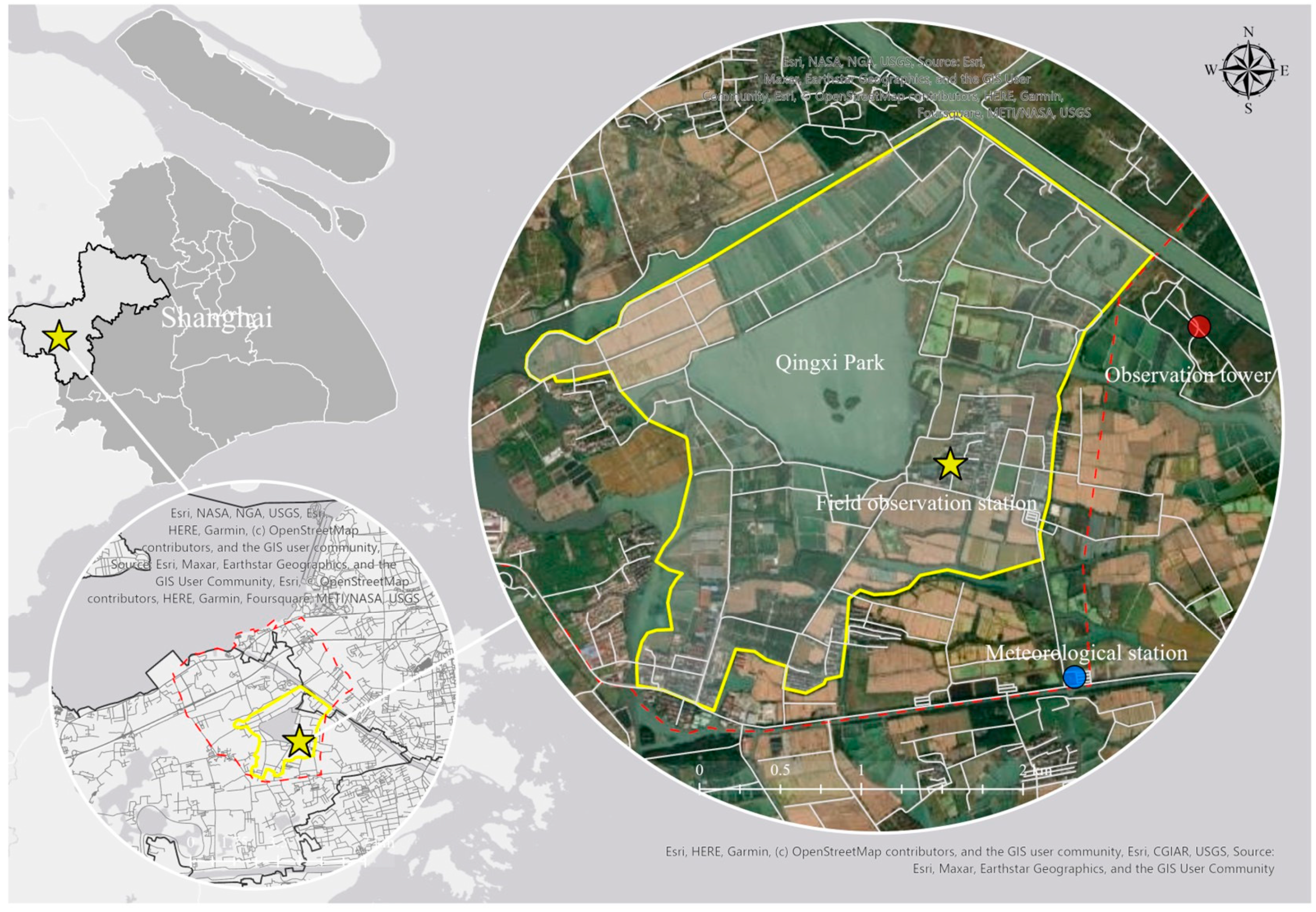
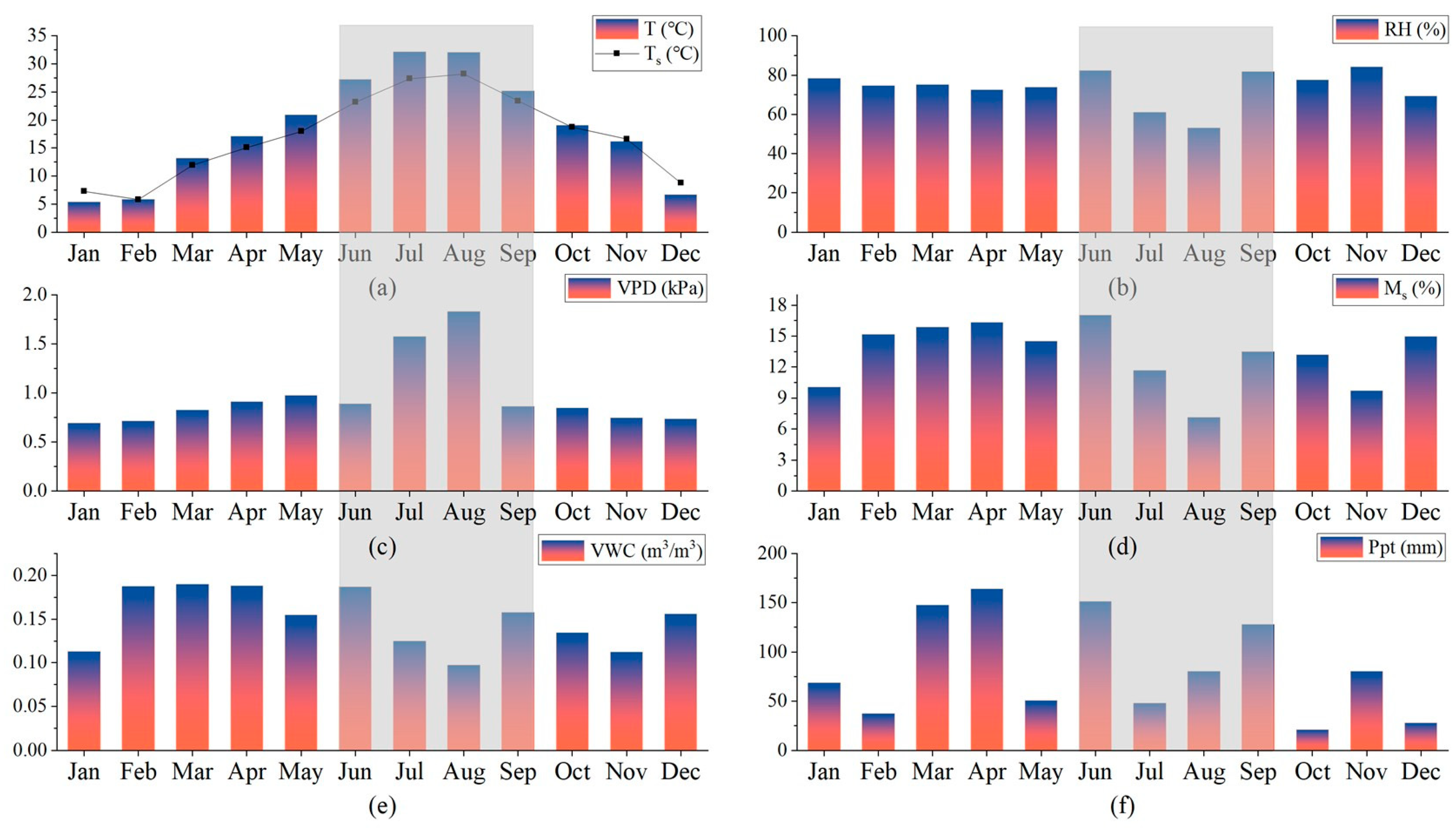

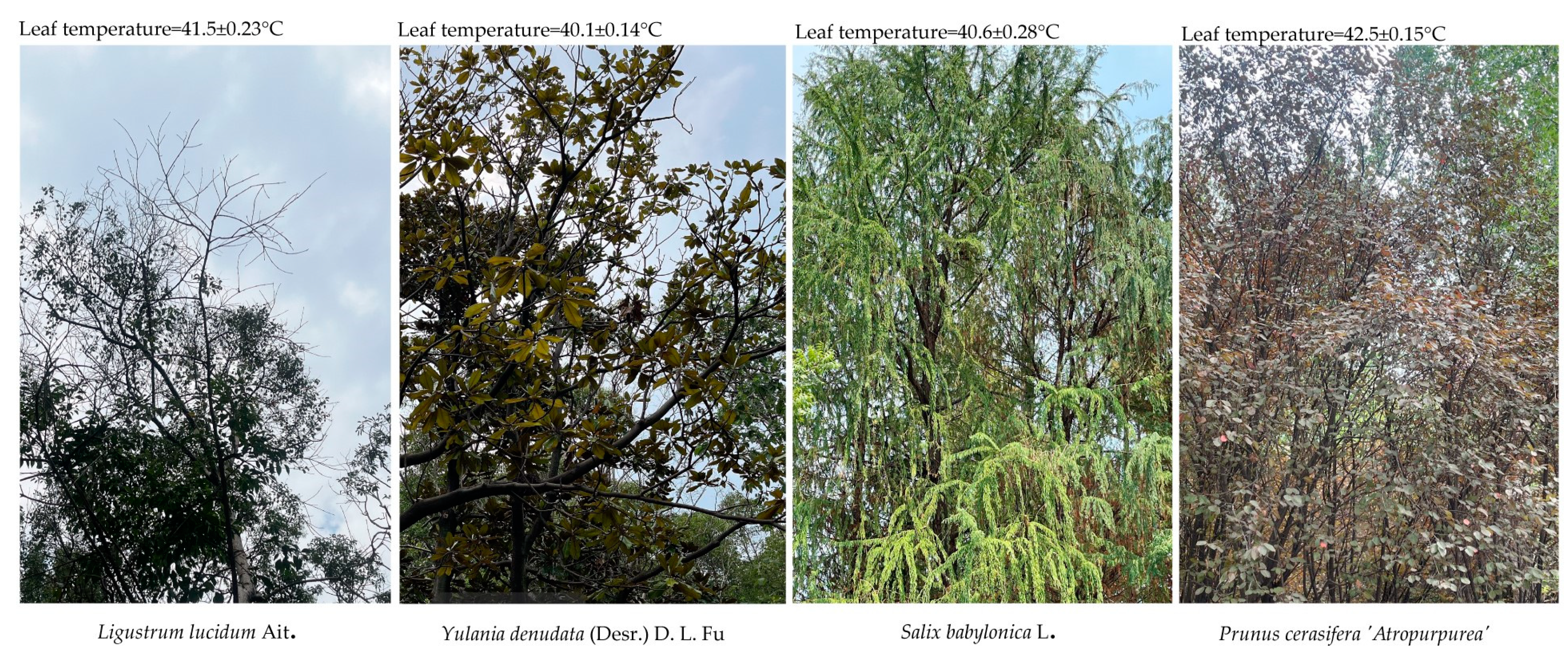

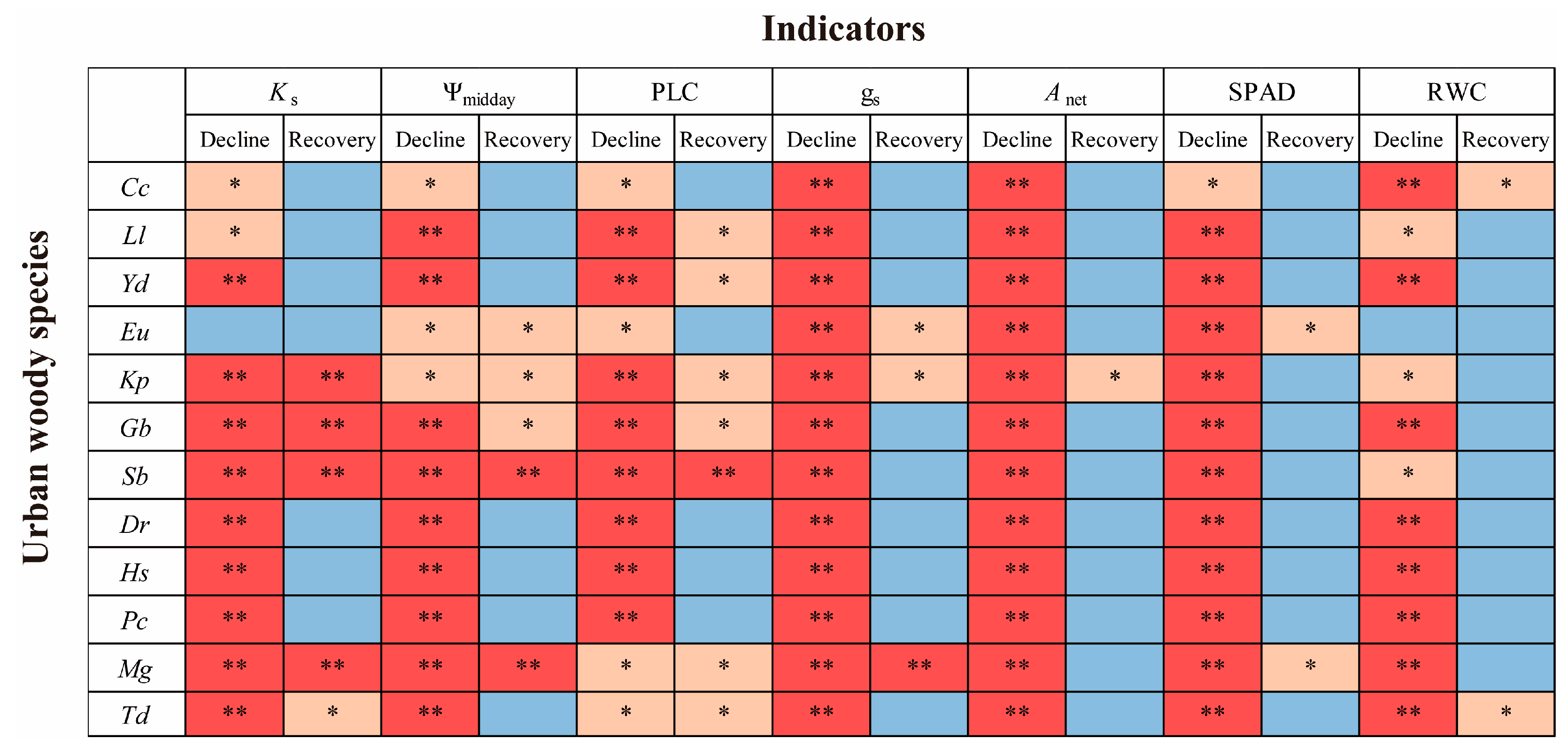
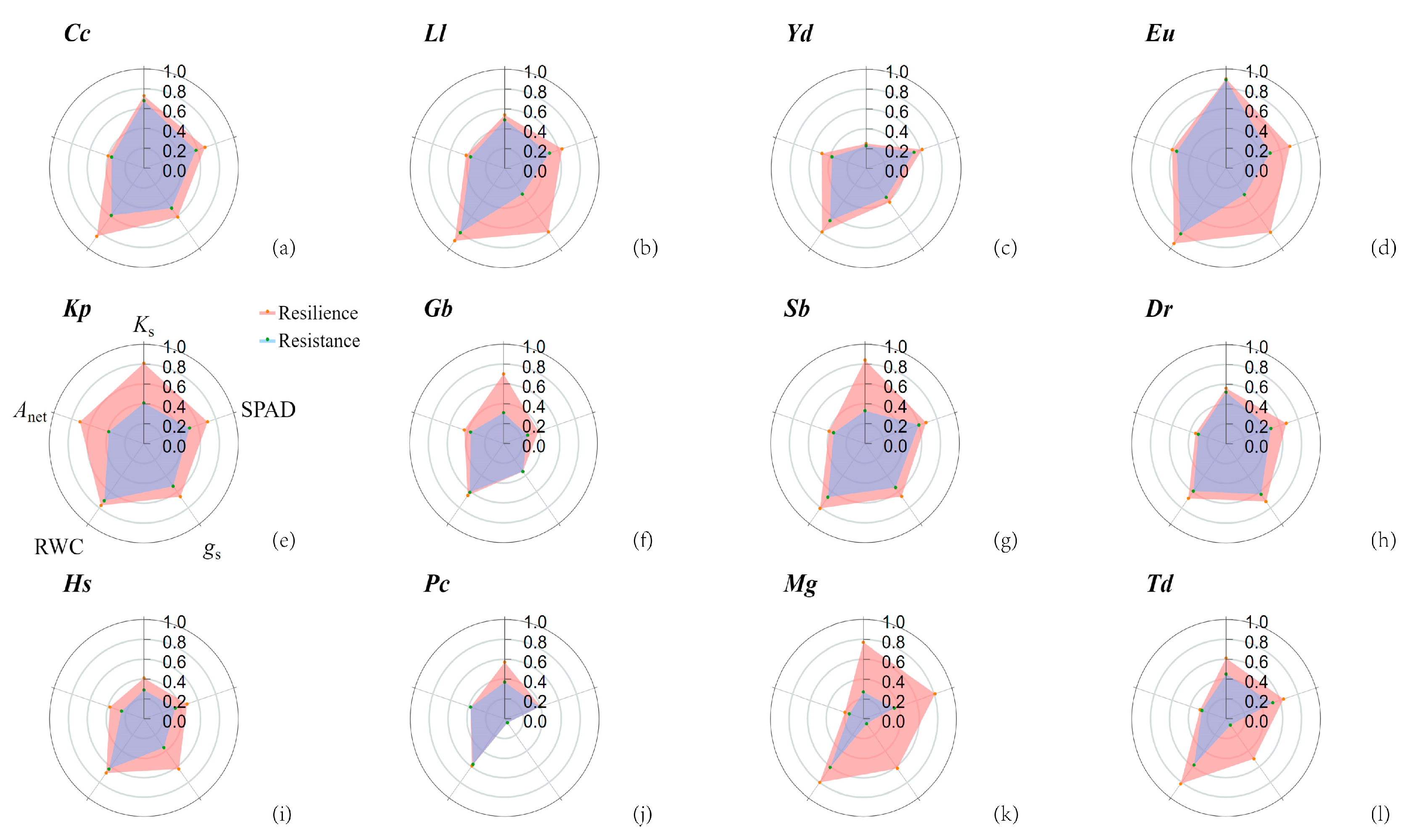
| Abbreviation | Description/Scientific Name | Unit | |
|---|---|---|---|
| Climate variables | T | Air temperature | (°C) |
| RH | Relative air humidity | (%) | |
| VPD | Vapor pressure deficit | (kPa) | |
| Ts | Soil temperature | (°C) | |
| Ms | Soil moisture content | (%) | |
| VWC | Volumetric water content | (m3/m3) | |
| Ppt | Precipitation | (mm) | |
| SPEI | Standardized Precipitation–Evapotranspiration Index | - | |
| Leaf traits | RWC | Leaf relative water content | (%) |
| SPAD | Relative value of chlorophyll content | - | |
| gs | Stomatal conductance | (mol−1 m−2 s−1) | |
| Anet | Leaf net CO2 assimilation rate | μmol m−2 s−1 | |
| Hydraulic traits | Ks | Stem hydraulic conductivity | (kg m s−1 MPa−1) |
| Ψmidday | Midday water potential | (MPa) | |
| PLC | Percent loss of hydraulic conductivity | (%) | |
| Species | Cc | Cinnamomum camphora (L.) Presl | - |
| Dr | Distylium racemosum Siebold and Zucc. | - | |
| Eu | Eucommia ulmoides Oliv. | - | |
| Gb | Ginkgo biloba L. | - | |
| Hs | Hibiscus syriacus L. | - | |
| Kp | Koelreuteria paniculata Laxm. | - | |
| Ll | Ligustrum lucidum Ait. | - | |
| Mg | Matasequoia glyptostroboides Hu and W.C. Cheng | - | |
| Pc | Prunus cerasifera ‘Atropurpurea’ | - | |
| Sb | Salix babylonica L. | - | |
| Td | Taxodium distichum var. Imbricatum (Nuttall)Croom | - | |
| Yd | Yulania denudate (Desr.) D.L. Fu | - |
| Species | Diameter at Breast Height (cm) | Height (m) | Crown Width (m) | Type | |||
|---|---|---|---|---|---|---|---|
| Cinnamomum camphora (L.) Presl | 14.2 ± 0.5 | 14.3 ± 0.7 | 8.6 ± 0.8 | Angiosperm | Tree | Evergreen | Broadleaf |
| Ligustrum lucidum Ait. | 7.6 ± 0.4 | 7.8 ± 0.7 | 3.8 ± 0.5 | Angiosperm | |||
| Yulania denudata (Desr.) D. L. Fu | 18.4 ± 1.1 | 15.6 ± 1.2 | 7.2 ± 1.1 | Angiosperm | |||
| Eucommia ulmoides Oliv. | 9.1 ± 0.5 | 9.5 ± 0.6 | 6.7 ± 0.8 | Angiosperm | Deciduous | ||
| Koelreuteria paniculata Laxm. | 15.4 ± 0.7 | 11 ± 0.3 | 7.5 ± 0.6 | Angiosperm | |||
| Ginkgo biloba L. | 6.5 ± 0.8 | 7.2 ± 0.6 | 5.3 ± 0.7 | Gymnosperm | |||
| Salix babylonica L. | 14.8 ± 0.6 | 14.9 ± 0.5 | 8.9 ± 0.9 | Angiosperm | |||
| Distylium racemosum Siebold and Zucc. | 5.3 ± 0.6 | 5.3 ± 0.9 | 3.8 ± 0.8 | Angiosperm | Shrub | ||
| Hibiscus syriacus L. | 6.2 ± 0.4 | 6.2 ± 0.9 | 4.8 ± 0.5 | Angiosperm | |||
| Prunus cerasifera ‘Atropurpurea’ | 8.1 ± 0.8 | 5.7 ± 0.7 | 5.9 ± 0.9 | Angiosperm | |||
| Metasequoia glyptostroboides Hu and W. C. Cheng | 15.7 ± 0.7 | 15.2 ± 1.3 | 6.8 ± 0.7 | Gymnosperm | Tree | Coniferous | |
| Taxodium distichum var. imbricatum (Nuttall) Croom | 12.6 ± 0.4 | 11.7 ± 0.8 | 6.1 ± 0.6 | Gymnosperm | |||
Disclaimer/Publisher’s Note: The statements, opinions and data contained in all publications are solely those of the individual author(s) and contributor(s) and not of MDPI and/or the editor(s). MDPI and/or the editor(s) disclaim responsibility for any injury to people or property resulting from any ideas, methods, instructions or products referred to in the content. |
© 2023 by the authors. Licensee MDPI, Basel, Switzerland. This article is an open access article distributed under the terms and conditions of the Creative Commons Attribution (CC BY) license (https://creativecommons.org/licenses/by/4.0/).
Share and Cite
Wang, Y.; Xing, C.; Gu, Y.; Zhou, Y.; Song, J.; Zhou, Z.; Song, J.; Gao, J. Responses and Post-Recovery of Physiological Traits after Drought–Heatwave Combined Event in 12 Urban Woody Species. Forests 2023, 14, 1429. https://doi.org/10.3390/f14071429
Wang Y, Xing C, Gu Y, Zhou Y, Song J, Zhou Z, Song J, Gao J. Responses and Post-Recovery of Physiological Traits after Drought–Heatwave Combined Event in 12 Urban Woody Species. Forests. 2023; 14(7):1429. https://doi.org/10.3390/f14071429
Chicago/Turabian StyleWang, Yongkang, Chen Xing, Yilin Gu, Yang Zhou, Jinyan Song, Ziyi Zhou, Jia Song, and Jun Gao. 2023. "Responses and Post-Recovery of Physiological Traits after Drought–Heatwave Combined Event in 12 Urban Woody Species" Forests 14, no. 7: 1429. https://doi.org/10.3390/f14071429
APA StyleWang, Y., Xing, C., Gu, Y., Zhou, Y., Song, J., Zhou, Z., Song, J., & Gao, J. (2023). Responses and Post-Recovery of Physiological Traits after Drought–Heatwave Combined Event in 12 Urban Woody Species. Forests, 14(7), 1429. https://doi.org/10.3390/f14071429





